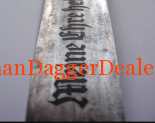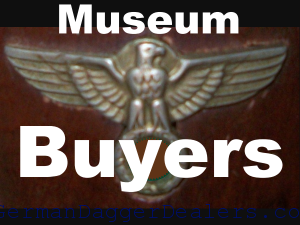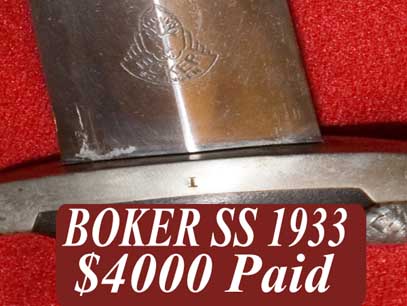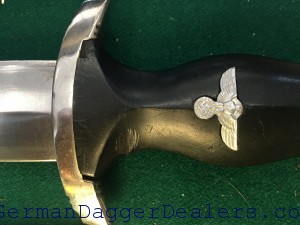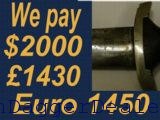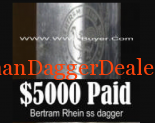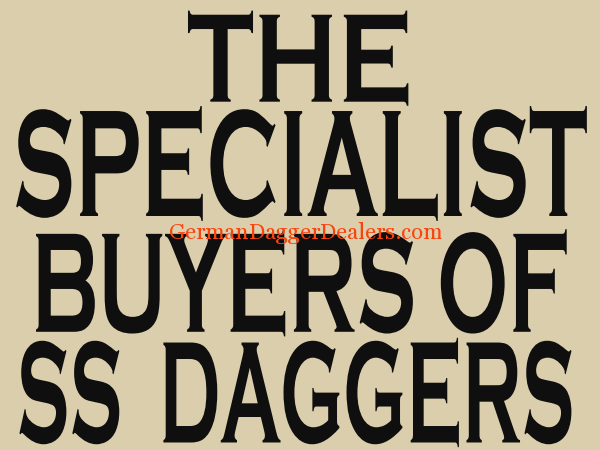WE ARE THE DEDICATED GERMAN DAGGER BUYING WEBSITE
VALUATIONS,ADVICE AND OFFERS ARE PROVIDED FREE OF CHARGE.
SS Dagger Specialists Believe that SS dagger collecting can be an absorbing hobby, however before embarking on your first SS dagger purchase it is better
to study the do’s and dont’s touched upon here.
SS Dagger Specialists believe that the enlightened customer are likely to continue with the hobby .
Buy your first SS from a trusted source preferably a dealer who offers a lifetime warranty.
A common mistake Is for the
budding enthusiast to buy an ss dagger from an auction site or a militaria fair in an effort to buy
close to source and save money..
Experienced collectors buy
from experienced dedicated professionals .
SS Dagger Specialists
1933 pattern SS dagger
The awarding of an SS dagger was a symbol of graduation All Candidates swore an
oath of lotalty to Adolf Hitler and only then were they able to wear an SS dagger.
Accepted Manufacturers of the first SS “33” Pattern daggers are : Eickhorn, Herder, Hammesfahr,
Boker, Klaas, and less frequently Pack, Bertram Rein, Klittemann & Moog, Jacobs, Schuttlehofer, Gembruch and Puma.
Other maker marked daggers do exist but they are rare and therefore should be approached with extreme caution
. More often than not they are not original so save yourself some grief and leave them to seasoned collectors.
BLADE
SS Dagger specialists state that
the condition the dagger’s blade most important .
Always look for complete blades.
Re tipped,
sharpened,and shortened blades
dramatically reduce value and should be avoided. Even nicks and scratches affect value.
SS blades are acid etched with the motto, “Meine Ehre heisst Treue” in some rare instances there is an exclamation mark “!” at the end of the motto.
SS Dagger Specialists will address the exclamation point daggers later.
The motto’s meaning is, “My word is my honor” or “My honour is loyalty”
the oath SS members made to Adolf Hitler.
Dark mottoes are more desirable than light mottoes.
Early maker marked blades and early RZM contract daggers are the most desirable, transitional Daggers are those with blades bearing a
maker’s logo marked and RZM marked) are the second most desirable, and finally, RZM marked blades are the least desirable.
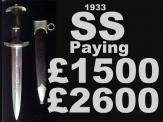
These RZM codes have been a source of confusion with collectors SS Dagger Specialists will explain the meaning of these codes.
There are two kinds of RZM codes on SS daggers. The first types are maker marks. Maker marks designate a code given
to individual companies replacing the company’s name. These numbers range from
RZM M7/1 through RZM M7/119. The prefix “RZM M7/” indicates a company maker mark.
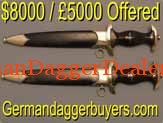
The second type of RZM numbers found on SS daggers is a code that runs from RZM 15 through to 1317.
These RZM code refer to a SS contract numbers, not a company. These codes always have two numbers.
The first is the contract number and the second the year of manufacture. So RZM 1198/40 translated
means RZM contract 1198 and the year 1940.
Lastly these contracts were issued to companies and in
some cases these companies subcontracted the daggers to other suppliers.
SS Dagger Specialists provide a list where you can see these codes.
CROSSGUARDS
Crossguards fall into 3 categories:
Solid Nickel
Plated
Metal
Solid Nickel crossguards are the most desirable. They stand the test of time and never deteriorate.
They will dull and develop a patina but will never lose their integrity.
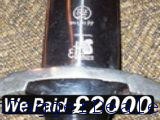
They were the first crossguards made and appear dull in finish. Normally for daggers made prior to 1936 they are stamped with
a “district mark” mark on the lower crossguard. This mark denoted the original issue location.
The district mark is always found on the back of the dagger. This is always a roman numeral.
This mark is stamped relatively centrally and normally longitudinally and in some cases sideways.
This is a list of the three accepted issue districts for SS daggers; “I” Munich, “II” Dresden, “III” Berlin.
Approximately 60% of daggers were issued in Munich, 30% in Berlin and the remains 10% in Dresden.
Each crossguard has eight deep grooves sometimes these are darkened and sometimes they are hand finished.
Occasionally you will also find these early crossguards stamped on the very bottom (facing the blade)
with a small single digit number; this is called a bench number and denotes who originally assembled the dagger or who inspected it.
Other markings can be found as well.
Serial numbers, unit markings and even names or dedications can be found.
These are so numerous that I cannot go into them all
here, but more often than not you will see these on the earliest
of crossguards.
SS Dagger specialists encourage you not to pay big premiums for these markings, most are just fine and in
some cases these have been added by forgers to increase resale value. As a result collectors always view these
with suspicion. In the case of high profile original owner’s serial numbers or personalization’s be even more careful. These photos illustrate examples of crossguards.
Plated crossguards came out later in the production of daggers as industry was forced to economize on materials.
They are never district stamped. These guards were made from die cast zinc or pot metal.
A thin copper flash was applied, (this allows the final plating to adhere to the base metal)
and then a chrome or nickel-plate on top of that. They normally appear shiny but can dull down from nicotine or airborne pollution.
The trouble with plating is that it must be done properly or it will, over time, bubble as the metal underneath corrodes.#
Today’s die casters have this down pat, but in the 30’s this was still an issue. Many plated fittings now display
lifting or corrosion. Lifting can be seen as a paper-thin layer of flexible metal rising up off the casting.
Underneath that lifting is corrosion. This plating can be removed by cleaning and buffing the fittings too much.
Keep in mind this plating is only a few tenths of a millimeter thick, once it’s gone, its’ gone.
My advice is don’t mess with them. Most times these fittings are unmarked on the exterior.
These plated crossguards exhibit deterioration that can be seen on plated parts. They are never district stamped.
Steel crossguards were another substitute for the early nickel fittings. These were used later in production and are rarely seen.
These guards have the advantage of not having the corrosion or lifting problems of plated fittings. Again they are never district stamped.
SS Crossguards
POMMEL NUT
Look to see if the nut shows scratches or signs of wear. This wear is due to people disassembling, and often, without the proper tools.
The more an item is disassembled the more chance it has of being messed with and/ or damaged.
In time the threads wear and have increased chances of being stripped. A pristine nut that has never been turned is a rarity today and desirable,
If your dagger has never been apart leave it alone.
Look for build up of patina on the nut flats this is a good indicator
of an unturned nut. Materials can be only nickel or nickel plated steel.
The important thing being that the material remains consistent with the rest of the fittings.
Rarely would any dagger leave the factory with mismatched fitting materials, and when you see one it should
be viewed with suspicion. As a side bar if you must take your dagger apart, don’t over tighten your pommel on
reassembly. Wood moves with humidity and temperature. If you do not allow for that movement, eventually the wood will give.
These nuts need not be any more than finger tight. Just ask the SS collector who reefed down on his pommel nut in
mid-winter only to wake up one humid June morning to see his prize possession chipped. Lastly use the right tool.
Pliers are not the right tool! Remember we are custodians of history.
SS Pommel Nut
GRIP
SS grips required much hand work in them, much care went into their production. Each grip went through a final fit process.
People today generally do not understand this. Everything you buy today is assembled from parts that are interchangeable.
In the 30’s daggers were still made by hand each piece being fit by a craftsman.
The fit of these things is what it’s all about and the grip is where everything comes together. Parts were made on
machines but the tweaking done by hand. It never ceases to amaze us when we see people selling parts on auction sites.
The poor buyers get this stuff and then wonder why things do not fit together correctly, well now you know
. Handles were made from hardwood never softwood. Makers tended towards some generalities so in time one
can see characteristics typical to individual makers. They were roughed out, sanded down, stained by boiling
the grips in black aniline dye, and then the inserts fit with care. This process of impregnating grips with dye tended to make
the grips brittle and susceptible to chipping, flaking and cracks. Depending on the maker and the batch of wood,
the dying process had varied success. We do see some grips today that can look brown. This is due to the dye not taking
well and or the way the dagger was stored. Typically early daggers tended to have softer lines than the RZM types
indicating more time and care had been taken in finishing. Original handles were never made of anything other
than wood. A plastic handle is a dead give away of a fake. The wood on SS daggers is notorious for chipping.
SS Grip
Eagle
Eagles are centrally placed in the grip and normally at the widest point of the grip. These eagles were very well fit with
very little clearances between the wood and the metal. Later daggers show greater tolerances and you can sometimes
see minor gaps. You will see the odd dagger that has been de-nazified. This was often done by digging at the eagle
with a sharp instrument. Evidence of this is easy to detect. I have seen shrinking of the wood push the eagle or
part of the eagle out. A wing slightly lifted out from the surface of the wood is sometimes seen and although
not desirable can happen. By the way, don’t worry,
the inlays are pinned in-place and don’t fall out easily. Just look closely at the eagle.
You will often see wear in the high areas, this is a good indication that it has not been replaced.
In use, the wearer often held the dagger from moving as can be seen from many period photos.
RZM daggers had nickel, aluminum, zinc or plated eagles. Sometimes these eagles have oxidized and look
to have powder on them. Others appear to be copper colored as the plating has gone completely leaving
just the copper flash coat visible. Less care was taken with these later
daggers and as a result some may appear to have less than perfectly fit eagles.
SS Eagles
Roundel
Roundels or insignias vary only slightly from dagger to dagger. I have seen the hue vary from bright silver to a
copper however they are all exactly 9mm in diameter. Sometimes the exposed enamel on these will flake off or
darken so look close. Roundels were made with care and even the latest vintage piece with have a well-made
enameled roundel. These roundels will be smooth and convex with evenly shaped runes. Individual makers
would buy their eagles and roundels from preferred suppliers and as a result we
can know what sort of eagle or roundel to expect when buying. This can provide a clue to authenticity.
SS Runes
SCABBARD
There are 2 common types of scabbards:
Anodized
Painted
The earliest most desirable examples are anodized. Again these early scabbards are the most desired by collectors.
Anodized scabbards exhibit the best workmanship. BTW, I say anodized but truly the scabbard steel was blued,
similar to the way guns are blued, and then lacquered. I say anodized because that is the common jargon used in
the hobby. They always came with solid nickel fittings. Nickel fittings are softer than steel and the balls are very
susceptible to bruising, so much so that fining a perfect nickel ball is near impossible. Over the anodizing was lacquer.
This lacquer often wears off and sometimes loose flakes can be rubbed off even with a soft cloth. Where the lacquer
remains you have a shiny finish and where only anodizing exists, it dulls to a matte finish. Many anodized
scabbards have lost all their original lacquer finish. As the anodizing wears off, you may see right down to bare metal or rust.
The painted scabbard was adopted after the anodized scabbards, I suspect to speed and simplify manufacturing.
The first made used up solid nickel fittings and very soon adopted the plated fittings.
Typically the paint was evenly and professionally applied. After drying the scabbard was assembled.
This involved inserting a lead weight into the bottom of the scabbard, then assembling the throat with spring runners
and the exterior fittings. Guys take your time when checking scabbards. If the fittings are nickel that means
all the fittings are non-magnetic, so check them with a magnet. That means the ball, the upper fitting, the ring and the throat.
All these parts should exhibit the same material, even wear and patina. Same thing for a scabbard with plated fittings
all parts should be magnetic. As with the earlier type scabbards, paint wore and chipped off from wear and in some
cases the paint is worn down resulting in rust and corrosion.
SS Dagger Specialists
Look closely at the item, dents scratches and
splits in the ball all depreciate value. Missing and or buggered screws can be an indication the scabbard was messed with.
By buggered screws I mean screws that have the heads messed up normally because someone used the wrong screwdriver.
I always look at the edges of the scabbard fittings. Marks there can indicate that someone has removed the fitting from the shell,
often to the detriment of the dagger. Finally, remove the blade and shake the scabbard, is the lead weight loose?
Disassemblers have messed up more daggers than I care to think about. Again the scabbard fitting material should
be consistent with the crossguard and nut material. If you see mismatched hues from the scabbard to the dagger,
look more closely, this may be evidence of switched parts. Below are examples of anodized and painted scabbards.
SS Dagger Specialists
SS Scabbards
FITS
To most experienced collectors this stuff is obvious, but to me when I was a beginner, I had to learn this from scratch.
These lessons literally cost me thousands of dollars. What I have to say is to the best of my knowledge.
There are exceptions to every rule and every piece you buy has to be evaluated on its’ own
merit. Most of what I have to say deals with purchasing daggers online. Hopefully this can be a starting place for the beginner.
SS Dagger Specialists
Handle to Crossguard Fits
Whenever 2 materials are brought together there is natural movement as a result of exposure to time, air, humidity and
temperature cycles. Wood tends to shrink over time as compared to metal, which is stable. As a result we see the grips’
ends shrinking away from the tips of the crossguard. The wood tends to shrink more with the grain than against the grain.
As a result you will often see small gaps (up to 2mm) where the tips of the handle once met the ends of the crossguards.
Closer fits are desirable. Gaps of more than 2mm should cause you to look more closely at the dagger.
Typically the shrinkage is uniform from side to side so a gap of .5mm on one side and a gap of 2mm on the other side
should be a red flag. Variable shrinkage could be caused by a change in the wood grain however the shrinkage
typically will not vary by more than 25%. Look closely at any patina between the grip and the guards.
Untouched patina is a great indicator a dagger is original and just another reason why not to clean and disassemble your daggers.
SS Dagger Specialists
Eagle and Roundel Fits
Look closely at the fits. I look to see that the wood surrounding the inlays is smooth. Cracks often have developed
over time that run lengthwise perhaps from the roundel up, or at the ends of the eagle. Although not desirable, these
are the natural result of time and improper protection against humidity and temperature cycling. Red flags would be
chipping around the inlays consistent with someone removing them. These inlays are almost impossible to remove
without damaging the adjacent wood. The harder and closer the grain the more susceptible to
chipping. Again later RZM daggers had more tolerance than early daggers around the eagles.
Crossguard to Blade Fits
Again look for a close fit. Seeing light or obvious gaps between the blade and the crossguard is a sign to look closer.
Again, I look for patina that is in this area. This can be a sign that the dagger blade is original to the crossguards.
As a note, I particularly look at this fit in early maker marked daggers. RZM daggers will often display less than
perfect fits. A poorly fit blade is a red flag. Unfortunately, the blade is the area most susceptible to “trick” photography.
The blade can look dramatically different depending on its’ angle to the camera. Always look for shots that are
straight on to the blade. Angle shots and shots looking down the blade always portray a darker than actual
motto. The below photos demonstrate how the same blade can look very different. A good test when buying a dagger is to hold the
bagger up to the sun and look for gaps between the blade shoulders and the crossguard. You should not see
light coming between these two areas. Sometimes you will see pictures of daggers completely disassembled.
I really hate seeing this and 99% of the time I pass on these pieces. Sellers who take apart daggers are often
inexperienced and trying too hard to prove it’s real. Even if there is no visible damage reassembly often results
in chips or cracks down the road. People tend to reef on the nut and the result is chips and cracks as the wood
moves over time. If the dagger is disassembled look for billet marks, (small lines up either side of the tang where
the blade was squeezed while working it) they should always be present. Buffer pads are small pieces of cloth
or leather that are sometimes cut to the oval shape of the scabbard and put between the blade and the lower
crossguard. These are another red flag. They tend to cover up poor fits and were rarely were used on period SA’s or SS daggers.
SS Dagger Specialists
Scabbard to Crossguard Fit
Look closely at the fit of the crossguard to the top or the scabbard. The patina should match. The radii should
be the same. If you see larger gaps on the ends than in the center or vise-versa, be suspicious. The space between
the 2 components should remain consistent. Pictures on left demonstrate a good fit and on right evidence of a parts dagger.
SS Dagger Fits
EXCLAMATION MARKED SS DAGGERS
Exclamation Marked daggers these have the motto, “Meine Ehre heisst Treue!” with an exclamation point. These
have been a subject debated among collectors for years. Some believe they are special presented pieces or
awards for certain achievements. I do not believe we have a conclusive argument at this point as to their purpose.
I can share with you a few things about their construction though. These were only made by the following maker
marks Klittemann & Moog and Jacobs. These producers also made daggers using the following RZM marks,
7/29, 324/37 and 324/38. The RZM marked daggers always used early quality nickel fittings and painted scabbards.
SS Dagger Specialists
SS Dagger Exclamation
MODEL M36
Well the chained SS or what some like to refer to as M36 dagger was authorized for wear in 1936.
This dagger essentially used the M33 but added a chain to the scabbard. In some cases we see a maker marked
dagger in a M36 scabbard. This might be the result of frugal owners purchasing just the new scabbard and replacing
their M33 scabbards with the new one. In other cases the daggers were “upgraded” later by returning Veterans,
collectors or dealers. The most desired configuration today is an M36 as it left the factory. All M36 daggers left the factor
y assembled with unmarked blades. What I mean by that is with just a motto on the blade, no maker mark or RZM markings,
the reverse of the blade is blank. The crossguards were unmarked. So for the remainder of this discussion
I will only address the chain. Two types of chain were made Type I and Type II. Both types were produced concurrently.
Type I
These chains are most easily discussed as they varied very little. The chains are always magnetic.
They always utilize die stamped links with square orifices. These links exhibit alternating sigrunes
and skull & crossbones with pebbled backgrounds. They always exhibit high detail however normally they do
not have any burnish to the backgrounds. The upper chain
has two links with a square spacer next to the scabbard body.
The link next to the spacer has a centrally placed deep
SS stamp to the reverse. The links are tied together using round
connectors with a decorative center line. The lower uses 4 links. The chain comes together at the top with a clover
leaf snap clip assembly. The link connecting the chain to the clover leaf used an oval shaped connector that appears
longer. This cloverleaf is made from two pieces. A standard clip with the cloverleaf soldered to it. Often if you peer
through the top hole you can see portions of “DRGM” in the clip underneath. . Take careful note of the shape and length of this clip. The chain assembly is secured to the
scabbard using small piece of plated steel which were soldered at the correct angle to the top fitting and the center
band. The center band is normally assembled to the scabbard body using two screws. Normally
Type I chains are assembled to anodized scabbards. These type chains often exhibit oxidizing and plating loss.
SS Dagger Specialists
Type I Chain
Type II
These chains were initially produced in nickel and later production was switched to steel. The early chain will be solid
nickel to include the clip, (with the exception of the internal spring), center mount and all links and connectors.
Nickel is nonmagnetic. Later chains will be steel based. You will get one or the other. Be very leery of chains
with mixed materials. If the chain is magnetic it should all be magnetic. The links always have burnished
backgrounds highlighting the alternating sig runes and skull & crossbones. They always utilize die stamped
links with rectangular holes with rounded corners. These links exhibit alternating runes and skull & crossbones
with pebbled backgrounds. They always exhibit high details, with some wear to the nickel chains. The upper chain
has two links with a square spacer next to the scabbard body. The link next to the spacer has a centrally placed
light SS stamp to the reverse. The links are tied together using thin soldered metal connectors with a decorative center line.
These connectors were notoriously weak and often broke or were twisted in wear. Period repairs to them are
sometimes encountered. The lower uses 4 links. The chain comes together at the top with a clover leaf snap clip assembly.
The links connecting the chain to the clover leaf used tapered connectors. Note the shape and size of this connector.
Often fakers get this wrong. This cloverleaf clip assembly is made from two pieces. A standard clip with the cloverleaf soldered to it.
This cloverleaf differs from the type I as the top hole is solid and not cut out so you can never see the clip through it.
Again I have provided detailed pictures below of an original example. Take careful note of the shape and length of this clip.
The chain assembly is secured to the scabbard using small piece of plated steel which were soldered at the correct
angle to the top fitting and the center band. The center band is normally assembled to the scabbard body using a single screw.
Early Type II chains are assembled to painted scabbards. Later anodized scabbards were used and these were assembled
using two screws at the center band. As production went on the edges of the center scabbard
band grew. Early center bands have very thin edges and later examples will have thicker edges.
Type I Chain
Gau Stamps
Gau stamped Crossguards. We do find examples of chained SS daggers with Gau stamped nickel crossguards.
These have been a mystery yet to be answered as to what the reason was for these.
To this day many discussions have surrounded these. What we do know is that these daggers always
have matching nickel crossguards and eagle nickel eagles. They are most often encountered with Type I scabbards.
The collecting community and all reputable dealers have come to accept these as a completely correct period variation.
SS Dagger Specialists
SIGNS OF AUTHENTICITY
Hanging Test:
Look at the dagger hanging from the scabbard ring/clip. It should hang at the correct angle approximately
45 degrees. If the angle looks wrong the scabbard could have been replaced or the lead weight could be missing.
Wear Test:
All wear should be consistent. If the handle is all banged up and the scabbard mint likely the scabbards is not original
to the piece. The only exception I’ve seen to this is a mint blade on an otherwise worn dagger. Perhaps the owner
never removed the blade. In the case I’m thinking about, the Vet who left his dagger in and attic for 40 years
deteriorating the exterior while leaving the sheathed blade protected from the ravages of time. All I’m saying is that inconsistent wear is a sign to look closer.
SS Dagger Specialists
Spotting Chained Fakes:
A couple things to be on guard against: One, the links should not have a seam on the edges. This is a telltale
sign to casting and links were never cast. The links should have perfectly flat backs, there should not be
wee holes or imperfections from casting. Look at the shape of the clips I have provided pictures of. Some modern repro’s now have elongated
clips. Finally look at the back of the clips, these were trimmed on 45 degree angles, fakers missed this detail,
(till now that I told them ?). Only now look at where the chain links rubbed against the connectors. These areas are key. Do they exhibit
honest wear? Now I’m telling you these details but while you are reading it so is some
guy in China who’s whole income is made from perfecting fakes. So every mistake they make only
makes a stronger case to buy this stuff from a Certified dealer.
SS Dagger Specialists
BUY THE CORRECT CONFIGURATION
Original daggers should have the correct configuration. In general look for the following:
Early Daggers (including early RZM contract daggers): Anodized scabbards nickel fittings
and crossguards district stamps Highest quality. . Early contract dagger makers are 120/34, 121/34 and 188/35.
Transitional Pieces: Anodized or painted scabbards nickel or plated fittings and crossguards (but they should be consistent and not mismatched).
Good Quality RZM pieces: Plated or Steel crossguards-less frequently nickel. Nickel, pot metal or aluminum eagles. Painted scabbards. Poorer fits.
SS Dagger Specialists
INTERNET PURCHASES
Commercial Terms
Buying from reputable sources on the internet provides lots of time to study your purchase and check it out well
before committing so is preferable in many ways to shows. Auctions sites however have inherent risk. You don’t
know the person; there is no relationship. The only basis you have to complete a sale is a Web Site,
User ID, or an email address. I have completed many thousands of online transactions and here are a few
do’s and don’ts. Yes, you will miss out on the odd deal but in general following these guidelines will save you grief.
Do’s:
Start collecting by purchasing from certified dealers who are reputable and honest.
Attempt to use an online payment service that allow charge-backs. Paypal allows
you to charge-back the seller in the case of non-receipt. A MO is only slightly safer than sending cash
Ask for an inspection period.
Check feedback from other auctions, if questionable, check with the other party to see if the
issue was resolved, but keep in mind that there are always transactions that go bad, even for the best of sellers.
Proceed very cautiously if you get offers to purchase “outside the auction site”.
Ask for more pictures.
Search the collector forums with the seller’s name, often problem sellers have a history.
Post on the collector forums if you have questions. Other collectors are your best source of info (polite questions from beginners are always answered).
Ask a collector moderator to help you out if you run into transactional problems. Never underestimate the power of these forums.
Ask for a respected person to inspect the item or act as an escrow agent for large transactions if you are not sure (Be sure to pay them for their services).
Treat your seller respectfully and honestly. Relationships are required to build a truly great collection.
Dont’s:
Bid on ‘Private Auctions” -often it’s the seller who’s hiding something.
Jump on a ridiculously low “Buy it Now” price. -Look before you leap.
Purchase from former east block countries. Save yourself a lot of heartache. If you, do insist on an escrow service!
Don’t pretend you know it all, there are few absolutes in our hobby and even seasoned collectors are occasionally surprised.
OkSA Daggers
Formed in 1921, the Sturmabteilung (SA) or “Brown Shirts”, functioned as the original paramilitary wing of the
Nazi Party (NSDAP). Comprised mostly out of WWI veterans and Freikorps (German volunteer military or
paramilitary units), the SA’s main function was to provide protection at Nazi rallies and assemblies.
The SA played a critical role in Hitler’s rise to power. The organization was co-founded by Adolf Hitler and Ernst Rohm,
and was later put under Rohm’s leadership. In 1934, Hitler’s ordered the “Blood purge” / the dis-empowering
of the SA which later became known as the “Night of the Long Knives”.
Like most NSDAP branches, the SA wore paramilitary dress and dagger.
The SA dagger was originally produced in vast quantities by 123 different cottage makers.
Initially these daggers were made with the highest quality, being produced out of hand-fitted nickel
fittings, hardwood grips and brown anodized or “blued” scabbards. The blades were etched,
“Alles für Deutschland”, or “All for Germany”. Pre-1935 SA daggers were stamped with the
SA group stamp to the reverse of the lower crossguard.
Later examples were RZM marked and used less expensive plated zinc-based fittings with painted scabbards.
 Given the size of the SA we do occasionally see other rarer daggers carried by this branch of service including the
Given the size of the SA we do occasionally see other rarer daggers carried by this branch of service including theSA and NSKK High Leader dagger, the Feldherrnhalle along with some very special presentation
pieces. If you would like to learn more about SA daggers we provide a video guide for beginning collectors.Honor Daggers Röhm Daggers NSKK Leader Daggers Early Daggers Transitional Daggers RZM DaggersHonor DaggersEarly SA Chained High Leader Dagger by Eickhorn
Early SA Chained High Leader Dagger by Eickhorn
We welcome the opportunity of purchasing untouched original SA High Leader Daggers The blades is are maiden
hair, hand-forged, Damascus steel construction. The obverse feature a muted gilt, raised out, SA motto which reads
“Alles Für Deutschland” and is flanked by oak leaf and acorn sprigs. The reverse displays that same prominent maiden-hair pattern.

Röhm Daggers
The blade on this one is in good condition but has been cleaned! The acid etched “Alles für Deutschland”
motto and maker mark are both crisply executed. The fit remains nice and tight and the tip comes ..
Early SA Dagger by E. GerlingA rare bird! This one rates 9 out of 10 for rarity on McSaars SA rarity rating list! The blade on this one is in excellent condition!
The acid etched “Alles für Deutschland” motto and “E. Gerling Solingen” maker mark are both
crisp and beautifully executed! The crossgrain is easily visible all the way from the hilt to the tip. The …Early NSKK Dagger by Curdts NachfAnother one from that huge collection! The blade on this one looks excellent! The acid etched “Alles für Deutschland”
motto and “Curdts Nachf Solingen” maker mark are both nicely executed! The crossgrain is easily visible
all the way from the hilt to the tip. The fit remains nice and tight and the tip comes to a perfect point! This …
Early SA Dagger by HacoA beautiful early SA Dagger! The blade on this one has been cleaned and it’s very nice. The upper reverse has some
minute scratches like someone tried to sharpen it. I say that but it’s not sharp
so maybe someonerubbed it across a rich or such. I tried to get this in a pic but could no you can only ..
Personalized Early SA Dagger by F. HerderI’ve seen a mark like this before, The Keys of Heaven! The bright blade on this one looks good! The acid etched
“Alles für Deutschland” motto and “F. Herder Solingen” maker mark are both nicely executed! The fit remains nice and tight and the tip comes to a perfect point!Early SA Dagger by F. W. HöllerMany of us have come across Höller marked pieces yet this is Höllers earliest maker mark (1933-1935) and is quite rare!
It rates 9 out of 10 for rarity! The bright blade on this one looks good! The acid etched
“Alles für Deutschland” motto and “F. W. Höller Solingen” maker mark are both dark, crisp and …
Rare Early SA Dagger by Eduard VittingThis one rates 10 out of 10 for rarity on McSaars rating! Crazy to even find it! The blade on this one looks great!
The acid etched “Alles für Deutschland” motto and “Eduard Vitting Solingen” maker mark are both crisp
and beautifully executed! The crossgrain is easily visible all the way from the hilt to the tip. The fit remains nice …
Early SA Dagger by Gebr. HellerAnother one from huge collection that we recently got in! The bright blade on this one looks good! The acid etched
“Alles für Deutschland” motto and “Gebr. Heller” maker mark are both nicely executed!
The crossgrain can be seen in the light. The fit remains nice and tight and the tip comes to a sharp point! This blade rates ..
Early SA Dagger by F. W. BackhausA great looking piece! The blade on this one looks great! The acid etched “Alles für Deutschland” motto and
“F. W. Backhaus Solingen” maker mark are both dark, crisp and beautifully executed!
The crossgrain is easily visible all the way from the hilt to the tip. The fit remains nice and tight and the tip comes to a sharp .
Early SA Dagger by Gust. Weyersberg
A rare maker and a beautiful piece! The blade on this one is in wonderful condition! The acid etched “Alles für Deutschland”
motto and “Gust. Weyersberg Nachf. Solingen GWNS” maker mark are both dark,
crisp and beautifully executed! The crossgrain is easily visible all the way from the hilt to the tip. The fit remains nice and tight and .
Early SA Dagger by Gebr. Becker
Check out that chef! The blade on this one looks great. The acid etched “Alles für Deutschland” motto and
“Gebr. Becker Solingen” maker mark are both beautifully executed! The crossgrain is easily
visible all the way from the hilt to the tip. The fit remains nice and tight and the tip comes to a perfect point! This blade rates
Early SA Dagger by Ernst. Bruckmann
A nice looking piece here! The blade on this one looks good.
The acid etched “Alles für Deutschland” motto and
“Ernst Bruckmann Solingen – Ohligs Mann” maker mark are both nicely executed! The fit remains
nice and tight and the tip comes to a perfect point! This blade rates an Exc. It has been heavily cleaned and shows minor ..
Early SA Dagger by Ludwig Groten
This one is about as rare as they come! This one rates 10 out of 10 for rarity on McSaar’s SA rarity ratting
The blade on this one looks decent. The acid etched “Alles für Deutschland” motto and
“Ludwig Groten Solingen” maker mark look good. The fit remains nice and tight and the tip comes to a sharp point! This ..
Early SA Dagger by Carl Jul. Krebs
A good one here! The blade on this one looks great! The acid etched “Alles für Deutschland” motto and “H & F. Lauterjung W. Solingen” maker mark are both beautifully executed! The crossgrain is easily visible all the way from the hilt to the tip. The fit remains nice and tight and the tip comes to a perfect point! This …
Transitional NSKK Dagger by Puma
A rare transitional example by a desired maker! The blade on this one is just beautiful!! It has a dark,
crisp and beautifully executed acid etched “Alles für Deutschland” motto and double marked maker
mark! The tip comes to a perfect point and the fit is nice and tight. The crossgrain wonderfully shines against the light! The blade rates .
Early NSKK Dagger by Malsch & Ambronn
I love the look of this maker mark! The blade on this one looks good. The acid etched “Alles für Deutschland”
motto and “Malsch & Ambronn Steinbach” maker mark are both beautifully executed!
The crossgrain is easily visible all the way from the hilt to the tip. The fit remains nice and tight and the tip comes to a perfect ..
Early SA Dagger by Carl Bender
The blade on this one looks good. The acid etched “Alles für Deutschland” motto and “Carl Bender Solingen”
maker mark are both beautifully executed! The crossgrain is easily visible all the way from the
hilt to the tip. The fit remains nice and tight and the tip comes to a perfect point! This blade rates Exc+. It shows heavy …
Early SA Dagger by F. Von Brosy
A rare maker mark on this one! This one rates 9 out of 10 for rarity on McSaar’s SA rarity ratting! The blade
on this one looks excellent! The acid etched “Alles für Deutschland” motto and “F. Von Brosy-Steinberg
Solingenmaker mark are both dark, crisp and beautifully executed! The crossgrain is easily visible all the way from the hilt to …
Add to Cart
Early SA Dagger by Thomas Wielputz
Early SA Dagger by Thomas Wielputz
A rare maker mark on this one! This one rates 9 out of 10 for rarity on McSaar’s SA rarity ratting! The blade
on this one looks excellent! The acid etched “Alles für Deutschland” motto and “Thomas Wielputz
Solingen-Hohscheid Gegr. 1880.” maker mark are both beautifully executed! The crossgrain is easily visible all the way from the hilt to the tip. ..
Early SA by Otto Simon
A nice dark motto from a maker 9 on the McSaar rarity scale. The blade on this one has a dark and deep acid etched
“Alles fur Deutschland” motto and maker mark both beautifully executed!
The crossgrain is still visible as you turn this in the sun! The fit is nice and tight and the tip comes to a perfect point. .
Early SA Dagger by Clemen & Jung
Another excellent example from huge collection that we recently got in! The blade on this one looks excellent!
The acid etched “Alles für Deutschland” motto and “Clemen & Jung Z Solingen” maker mark are both
beautifully executed! The crossgrain is easily visible all the way from the hilt to the tip. The fit remains nice and tight and the tip .
Early SA Dagger by Otto Simon
A rare maker on this one! It rates 9 out of 10 for rarity on McSaar’s SA rarity rating list! The blade on this one looks good.
The “Alles für Deutschland” motto and “Otto Simon Steinbach Kr.M.”
maker mark are both beautifully executed! The crossgrain shines quite nicely in the light, running the full length of the blade. The ..
Earliest SA Dagger by Eickhorn
This piece would have been among the preliminary Eickhorn production of SA Daggers! The cleaned blade on
this one looks good. The acid etched “Alles fur Deutschland” motto and large double oval “Carl Eickhorn
C.E. Solingen” maker mark are both nicely executed! The fit remains nice and tight and the tip comes to a perfect point! This blade rates .
McSarr SA Rarity Rating
A must for the serious SA collector, this lists all the makers by rarity and is the most recent issue.
This is an original 2 side example in a protective plastic cover. It will be shipped
1st class mail at No Charge. Great opportunity to support our hobby researchers! No pic supplied for obvious reasons! 🙂 .
Add to Cart
Transitional NSKK Dagger by C. Eickhorn
Always nice to see a transitional piece! The blade on this one looks great! The acid etched
“Alles für Deutschland” motto and transitional “RZM M7/66 1938” / “Eickhorn
Solingen Original” maker marks are all dark, crisp and beautifully executed! The crossgrain is easily visible from hilt to tip.
Transitional NSKK Dagger by Puma
A rare transitional example by a desired maker! The blade on this one is just beautiful!! It has a dark,
crisp and beautifully executed acid etched “Alles für Deutschland” motto and double marked maker mark! The tip comes to a perfect point and the fit is nice and tight.
Transitional SA Dagger by Eickhorn
Transitional Eickhorn SA’s are the most abundant of a transitional’s. The blade on this one loloks excellent!
The dark and crisp acid etched “Alles für Deutschland” motto and double “Eickhorn Solingen”/“RZM M7/66 1939” maker mark are beautifully executed!
Add to Cart
RZM Daggers
RZM M7/27 SA Dagger by Puma
Here’s a good looking RZM piece with a nice dark motto! The blade on this one looks great. The crisp acid etched
“Alles fur Deutschland” motto is beautifully executed and the “RZM M7/27” (Pumawerk (Lauterjung & Sohn), Solingen) maker mark is a bit lightened losing most it’s burnish.
RZM M7/72 (Karl Rob. Kaldenbach) SA Dagger
A solid example here! The blade on this one rates NM. The crossgrain is beautiful against the light, the tip and fit
are both perfect and the dark motto and maker mark are both beautifully executed! There are the common
runner marks and light evidence of a few fingerprints. The brown painted scabbard has 99% of its original paint still intact .
SA Dagger by RZM M7/42 (WKC)
A nice looking piece here! This one was previously owned by Simply Daggers in the U.K. I will just use his previous description:
“I am on a run at the moment for very nice condition daggers,
RZM M7/8 NSKK Dagger
A nice piece! The blade on this one looks great! The dark and crisp acid etched “Alles fur Deutschland” motto
and “RZM M7/8” (Eduard Gembruch, Solingen-Grafrath) maker mark are beautifully executed! The crossgrain is wonderful as you shine it in the light!
Here’s a nice looking RZM piece! The blade on this one looks great. The crisp acid etched “Alles fur Deutschland”
motto and “RZM M7/27” (Pumawerk (Lauterjung & Sohn), Solingen) maker mark are both beautifully
executed! The crossgrain is stunning as it shines against the light, all the way from the hit to tip! The tip is perfect and the fit ..
RZM M7/68 NSKK Dagger 1941
A nice example here! The blade on this one rates Exc++. The crossgrain is beautiful against the light, the tip and
fit are both perfect and acid etched “Alles fur Deutschland” motto and “RZM M7/68” (Tigerwerk Lauterjung & Co.,
Solingen) maker mark are both dark, crisp and beautifully executed! There is the common age greying throughout.
SA/SS Dagger Wrench
The perfect piece when the job calls for it! We created here a precise wrench for taking apart
SA and SS Daggers. I’ve seen people damage pommel nuts using the wrong tool for the job,
